Theme Parks & Themed Entertainment
Why For was the Excavator never built at Disney’s Animal Kingdom Park?

Fluffy-Not-Fat sent me a new Why For question earlier this
week, saying:
As a longtime fan, it’s great that you’ve begun writing
theme park history stories again. Those stories were always my favorite part of
your site.
So now that I’ve kissed your butt a little, I was wondering if you’d take a
request: I’m a coaster enthusiast. And I’d love to see a story on JHM about the
coaster which was supposed to be one of Dinoland U.S.A.’s opening day attractions
that never got built.
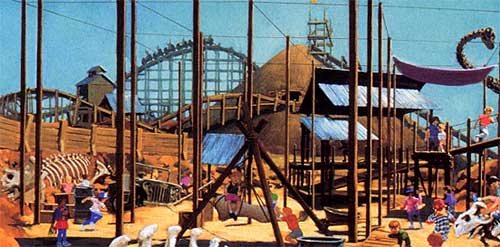
Please note the roller coaster that looms in the background of this piece of concept art
for Dinoland, U.S.A.’s Boneyard kiddie play-and-exploration area. Copyright Disney
Enterprises, Inc. All rights reserved
You’re asking about the Excavator. Which according to the
initial marketing study for Disney’s Animal Kingdom (which The Walt Disney
Company did back in the Summer of 1993) was supposed to be …
… a rollicking coaster ride through a section of the dig
supposedly too dangerous to enter. Somehow, we’ve gotten in and are having a
real good time.
So how would the Excavator have fit in at DAK? Well, you
have to understand that Dinoland U.S.A. has a very specific backstory.
According to the mythology that the Imagineers created for this Animal Kingdom “land,”
this part of the park started out life as the site of a sand and gravel
company. And Chester and Hester’s was just the local gas station which used to
service & fuel up all of the trucks and heavy equipment that would then
rumble in & out of this worksite.
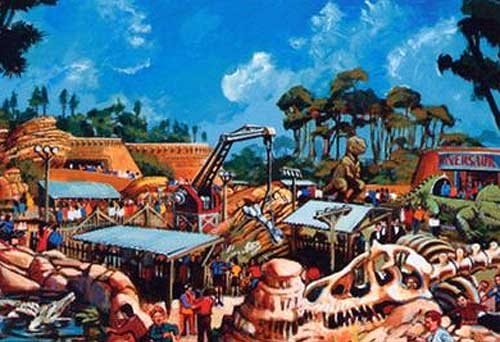
In the center of this Dinoland U.S.A. concept painting, please note the red backhoe which
has a massive dinosaur bone dangling from it. This is the archaelogical discovery that
set this area’s transformation from sand-and-gravel pit to paleontological playground
into motion. Copyright Disney Enterprises, Inc. All rights reserved
But then one day, as a backhoe is digging up sand to load into
the back of a dump truck, the workmen uncovered this massive dinosaur bone. So
they called in the scientists. Who then discovered that – just below the
surface of this huge sand & gravel pit – is the archaeological find of the
century. An area that’s just loaded with all of these perfectly preserved fossils.
So the wealthy benefactor for a local college immediately
swoops in and buys up this sand & gravel pit – lock, stock and T-Rex bones.
And he then turns what used to be this sand pit’s on-site field offices (i.e.
where the workmen used to go change & shower after a sweaty day of hauling
gravel. More importantly, where the employee cafeteria was located) into a dorm
for the students of that college’s paleontology department. Who will now spend
their summers working this newly-discovered dig.
And if you’re really paying attention as you walk by
Restaurantosaurus, you can see ample evidence of these crazy college students.
From that pyramid of beer cans which has been built right next to those chairs which have been set out on this building’s roof to those piles of shoes,
clothes and underwear which have been placed down by the shore of Discovery River
(which is supposed to suggest that these kids have gone skinny-dipping), it’s
clear that a group of hard-working, hormone-crazed university students are now
calling this place home. At least for the summer.

Copyright Disney Enterprises, Inc. All rights reserved
“And what of Chester & Hester?,” you ask. Well, since
they could no longer rely on selling fuel to all of the trucks that used to trundle
in & out of this sand pit (not to mention selling gas & oil to all the
hard-working men who used to haul gravel here), Chester & Hester had to
kind of reinvent themselves. And since this former sand & gravel pit is now
a world-famous archaeological site … Well, they’re getting lots of looky-loos
lately. Tourists driving out to see if they can spot any dinosaur bones and
then going away disappointed, because (according the backstory that the
Imagineers have put together for Dinoland, U.S.A. ) this site is now closed to
the public.
Sensing that there’s money to be made here if they just give
the tourists what they wants, Chester & Hester transform their remote gas
station into this dinosaur-themed roadside attraction.
“And where does the Dino Institute fit into Dinoland, U.S.A.’s
overall story?,” you query. Well, that same wealthy benefactor who initially
bought this sand & gravel pit for that unnamed university then became
obsessed with the central mystery of this amazing archaeological site. As in:
Why is it that so many perfectly preserved dinosaur skeletons can be found in
this one spot? What exactly happened here millions & millions of years ago?
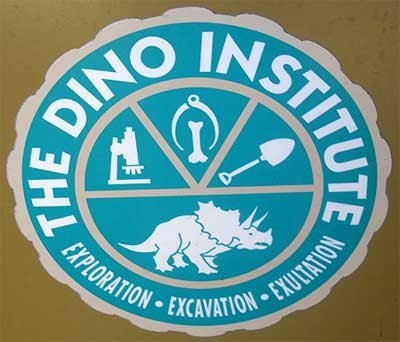
Copyright Disney Enterprises, Inc. All rights reserved
And the only way to solve this particular mystery is – of course
– to travel back into time and then attempt to observe whatever it was that actually
caused this massive dino die-off. So this wealthy benefactor then pours
billions into the creation of the Dino Institute, which specialized in chronological research. Which then results in the invention of
the Time Rover. And then … Wait a minute. We’re kind of getting away from what was
supposed to be the main focus of today’s Why For column. Which was the
Excavator.
Anyway … In the initial
mythology that the Imagineers worked out for Dinoland, U.S.A., the Excavator
was supposedly to be a piece of equipment which was left over from this archaeological
site’s sand-and-gravel-pit days. It was this series of ore cars that had once
been used to haul materials up out of the heart of this pit over to the area
where the dump trucks got loaded up. But over time, due to over-digging, as the
sand in this pit began to shift, the Excavator began to be really unsafe to
operate.
So the sand and gravel company then basically shut this series
of ore cars down. And the Excavator stands empty and abandoned for a few years,
becoming even more rickety and unsafe. And then that wealthy benefactor buys
this sand-and-gravel pit and sets all of these crazy college students loose on
this massive archaeological site.
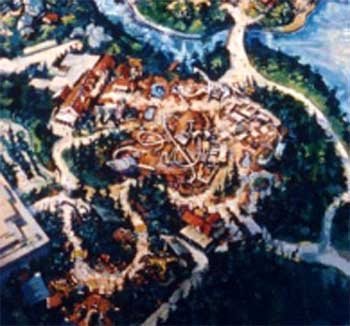
Close-up of initial Disney’s Animal Kingdom concept painting
which shows where the Excavator was originally supposed to
be built inside of the borders of Dinoland, U.S.A. Copyright
Disney Enterprises, Inc. All rights reserved
“And what do these college kids do with this obviously unsafe
piece of industrial equipment?,” you ask. Why they fire it up again, of course.
Not only because the Excavator is fun for them to ride. But also because they’re
now using these old, rusty ore cars to haul some of the larger dinosaur bones
that they’ve discovered around this archaeological site back to base camp.
Which explains the whole ” …. section of the dig supposedly
too dangerous to enter” part of the Excavator’s mythology. And for the ” … Somehow,
we’ve gotten in and are having a real good time” part of this backstory … As Guests
moved through the queue for this proposed Dinoland, U.S.A. attraction towards
the load / unload area, they were to have walked past literally dozens of “Condemned”
signs. Not to mention all sorts of safety barriers that this
sand-and-gravel-pit’s workmen had set up that the college students have recently
pulled down.
As for the layout of this proposed DAK thrill ride, the
Imagineers were looking to one-up Big Thunder Mountain Railroad. So instead of rolling
past a T-Rex fossil that was sticking out of this attraction’s rockwork …
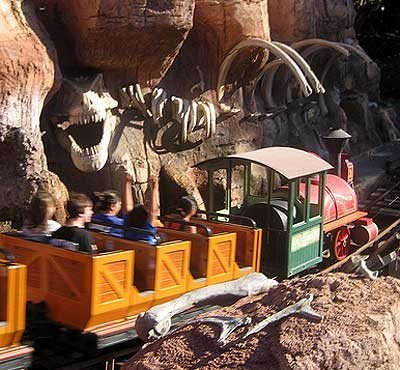
Copyright Disney Enterprises, Inc. All rights reserved
… On the Excavator, your ore car was actually supposed to
zoom through a massive dinosaur skeleton.

Copyright Disney Enterprises, Inc. All rights reserved
And before you came back into the load / unload area, your
ore car was supposed to loop by Chester & Hester’s. Where one of the folk
art dinosaur sculptures that they’d built for their roadside attraction would
suddenly lurch to life and then menace a trainload of tourists.
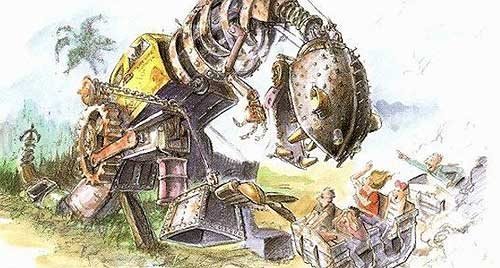
Copyright Disney Enterprises, Inc. All rights reserved
This sounds like a really fun attraction, don’t you think?
So why wasn’t Dinoland, U.S.A.’s Excavator ever built?
Well, to be blunt, the Imagineers learned a lot of hard
lessons on Disney’s Animal Kingdom. Chief among these is that – when you’re
building an attraction which is supposed to be used to display animals – much
of your budget is going to spent on things that the public never ever sees or
appreciates. Perimeter fencing and safety moats, for starters. Not to mention all
of those back-of-the-house barns where your ridiculously expensive menagerie then
goes to bed down for the night. Which has to be custom-built because (of course) a
facility that fits a giraffe isn’t going to work for an elephant or a hippo.
And as the projected cost of what was then-known-as Disney’s
Wild Animal Kingdom began to mount (quickly moving from its originally-budgeted
$600 million to over $850 million), pieces of this project began falling by the
wayside. First to be dropped was Beastlie Kingdomme, which was cut as an
Opening Day “land” for this theme park back in January of 1994.
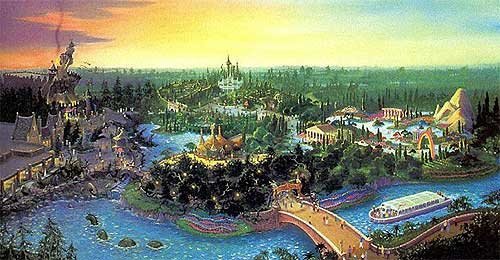
Copyright Disney Enterprises, Inc. All rights reserved
Next to be pushed back was the Excavator. Mostly because the
Imagineers felt that – if they just reused the ride vehicle & track
layout which had been developed for the Indiana Jones Adventure (which – let’s
remember – was supposed to open at Disneyland Park in March of 1995) for Countdown to Extinction / Dinosaur … Well,
that was a way to get a thrill ride into Disney’s Animal Kingdom’s opening day
assortment of attractions without then having to spend all of the time &
the money necessary to design & develop a custom-built coaster like the
Excavator.
“So once Disney’s Animal Kingdom opened in April of 1998,
why didn’t the Imagineers then circle back around to the idea of building the
Excavator?,” you ask. “I mean, clearly WDI thought that this theme park needed
a coaster / runaway mine train ride. Otherwise they never would have built
Expedition Everest. So why didn’t they just go ahead with construction of the
Excavator?”
Well, you have to remember that – right after Disney’s
Animal Kingdom opened – two of the main complaints that Guests had about this “Nahtazu”
was A) there weren’t enough rides, shows and attractions here to warrant
calling DAK a full-day theme park and B) very few of Animal Kingdom’s
attractions were kid friendly.
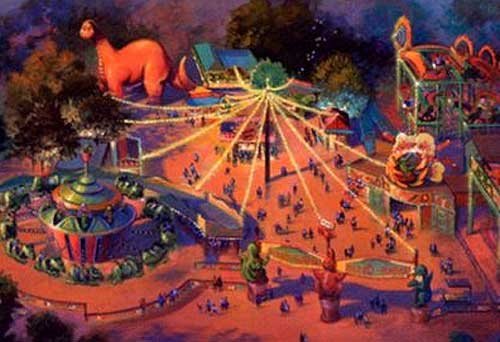
Copyright Disney Enterprises, Inc. All rights reserved
So given that WDI felt that it had to address these
particular Guest concerns quickly, the Imagineers took the DAK expansion pad which
had been set aside for the Excavator and then built Chester & Hester’s
Dino-Rama right on top of that. Which was this brand-new mini-land that featured
kid-friendly carnival rides like TriceraTop Spin and Primeval Whirl.
And as for the Excavator ride concept … Well, for a time, it
was part of the initial ride line-up for Hong Kong Disneyland. In the official November 1999 announcement of
this 126-hectare theme park, Adventureland was supposed to have been home to a
high-profile attraction which was supposed to have given Guests …
… the opportunity to venture into a wild untamed world and
ride a roller coaster through a dark jungle filled with mysterious surprises.
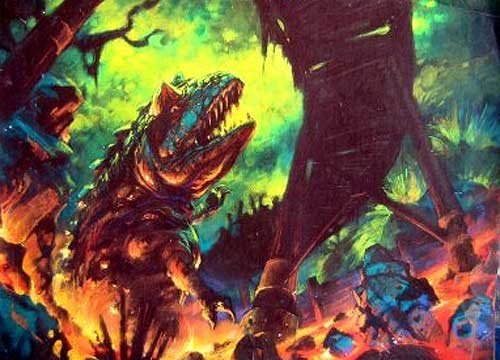
Copyright Disney Enterprises, Inc. All rights reserved
And according to what I’ve heard from the Imagineers who
actually worked on this proposed HKDL attraction, this coaster was initially
supposed to have been the replacement for Adventureland’s Jungle Cruise. Which
(back in 1999, anyway) was thought to be too slow, low tech & old-fashioned
to really appeal to the sophisticated folks who live in Hong Kong.
So in the place of The Jungle Cruise, the Imagineers wanted
to build a thrill ride that took the Excavator’s ride system and then married
that to all of the AA figures that Guests see as they roll through DAK’s “Dinosaur”
ride. Now place this coaster / runaway mine train inside of a thick,
Primeval-looking jungle and you’ve then got a thrill ride which would blow the doors
off of Universal‘s Jurassic Park River Adventure.
And as for this proposed coaster’s post-show area (i.e. where
the kids who were too small to ride could wait while their parents / older
siblings were experiencing this HKDL attraction) … Well, WDI was looking to possibly
reuse that Boneyard play-and-exploration area which they had initially designed
& built for Disney’s Animal Kingdom theme park.
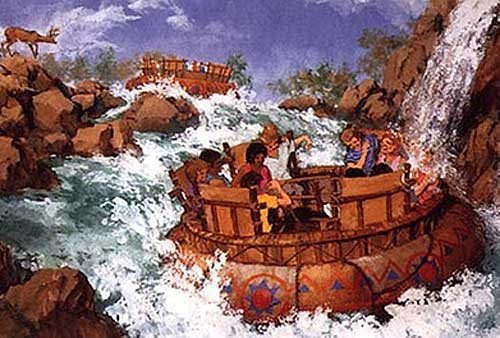
Copyright Disney Enterprises, Inc. All rights reserved
But as happened with Disney’s Animal Kingdom back in 1994,
the financial realities that the Imagineers were dealing with when it came to the
Penny’s Bay worksite eventually resulted in a severe reduction-in-scope on this
particular project. So instead of building a version of Disneyland which would
have replaced Frontierland‘s placid Rivers of America with a whitewater raft
ride (which – for all of you Disney’s America fans out there – was WDI just attempting
to repurpose the Lewis and Clark Expedition attraction concept which had initially
been developed for the Native American section of this history-based theme
park) … What Hong Kong Disneyland wound up with instead was a super-sized
version of Adventureland. But instead of
having Frontierland’s steamboats and canoes float past Tom Sawyer’s Island,
this theme park’s central waterway had Jungle Cruise launches chugging past Tarzan’s
Treehouse.
But that’s kind of the nature of the beast when it comes to
Disney theme parks. The Imagineers propose something during the initial
development phase of a project. And then the construction timeline shifts
and/or the budget gets revised. And as a direct result, an attraction which
sounds like it would have been a heck of a lot of fun never quite makes it off
of the drawing board.
Anyway, that’s the story of DAK’s Excavator. Please remember
that if you have any Disney-related questions which you’d like to see answered
as part of a future edition of this JHM column to send your queries along to whyfor@jimhillmedia.com.
Your thoughts?
History
The Super Bowl & Disney: The Untold Story Behind ‘I’m Going to Disneyland!’

One of the highlights of the Super Bowl isn’t just the game itself—it’s the moment when the winning quarterback turns to the camera and exclaims, “I’m going to Disney World!” This now-iconic phrase has been a staple of post-game celebrations for decades. But where did this tradition begin? Surprisingly, it didn’t originate in a stadium but at a dinner table in 1987, in a conversation involving Michael Eisner, George Lucas, and aviation pioneers Dick Rutan and Jeana Yeager.

The Unlikely Beginning of a Marketing Sensation
To understand the origins of this campaign, we have to go back to December 1986, when the Rutan Voyager became the first aircraft to fly around the world without stopping or refueling. Pilots Dick Rutan and Jeana Yeager completed the nine-day journey on December 23, 1986, flying over 26,000 miles before landing at Edwards Air Force Base. Their historic achievement earned them national recognition, and just days later, President Ronald Reagan awarded them the Presidential Citizen Medal at the White House.
Meanwhile, Disney was gearing up for the grand opening of Star Tours at Disneyland, set for January 12, 1987. Following its usual playbook of associating major theme park attractions with real-world pioneers, Disney’s PR team invited astronauts Gordon Cooper and Deke Slayton to the launch event. But in a twist, they also invited Rutan and Yeager, who were still making headlines.

A Dinner Conversation That Changed Advertising Forever
After the Star Tours opening ceremony, a private dinner was held with Disney CEO Michael Eisner, George Lucas, and Eisner’s wife, Jane. During the meal, Eisner asked Rutan and Yeager, “You just made history. You traveled non-stop around the planet on a plane without ever refueling. How are you ever going to top that, career-wise? What are you two gonna do next?”
Without hesitation, Jeana Yeager replied, “Well, after being cramped inside that tiny plane for nine days, I’m just glad to be anywhere else. And even though you folks were nice enough to fly us here, invite us to your party… Well, as soon as we finish eating, I’m gonna go over to the Park and ride some rides. I’m going to Disneyland.”
Jane Eisner immediately recognized the power of Yeager’s statement. On the car ride home, she turned to Michael and said, “That’s a great slogan. I think you should use that to promote the theme parks.” Like many husbands, Michael initially dismissed the idea, but Jane persisted. Eventually, Eisner relented and pitched it to his team.
The Super Bowl Connection
With Super Bowl XXI just around the corner, Disney’s PR team saw an opportunity. The game was set for January 25, 1987, at the Rose Bowl in Pasadena—just miles from Disney Studios. What if they convinced the winning quarterback to say, “I’m going to Disneyland” live on-air?
Disney quickly struck a deal with both quarterbacks—Phil Simms of the New York Giants and John Elway of the Denver Broncos—offering each $75,000 to deliver the line if their team won. Simms led the Giants to victory, making history as the first athlete to say, “I’m going to Disney World!” on national television.
A Marketing Triumph
That year’s Super Bowl had the second-highest viewership in television history, with 87 million people watching Simms say the famous line. The next day, Disney turned the clip into a national commercial, cementing the phrase as a marketing goldmine.
Since then, “I’m going to Disneyland” (or Disney World, depending on the commercial) has been a staple of championship celebrations, spanning the NFL, NBA, and even the Olympics. What started as a casual remark at dinner became one of the most successful advertising campaigns in history.
A Lasting Legacy
Jane Eisner’s keen instinct and Disney’s ability to act quickly on a great idea created a tradition that continues to captivate audiences. The “I’m going to Disneyland” campaign remains a testament to the power of spontaneous inspiration and smart marketing, proving that sometimes, the best ideas come from the most unexpected places.
To learn more about Disney’s ties to the world of sports, check out I Want That Too: A Disney History and Consumer Product Podcast.
Television & Shows
How the Creators of South Park Tricked A-List Celebrities to Roast Universal – “Your Studio & You”
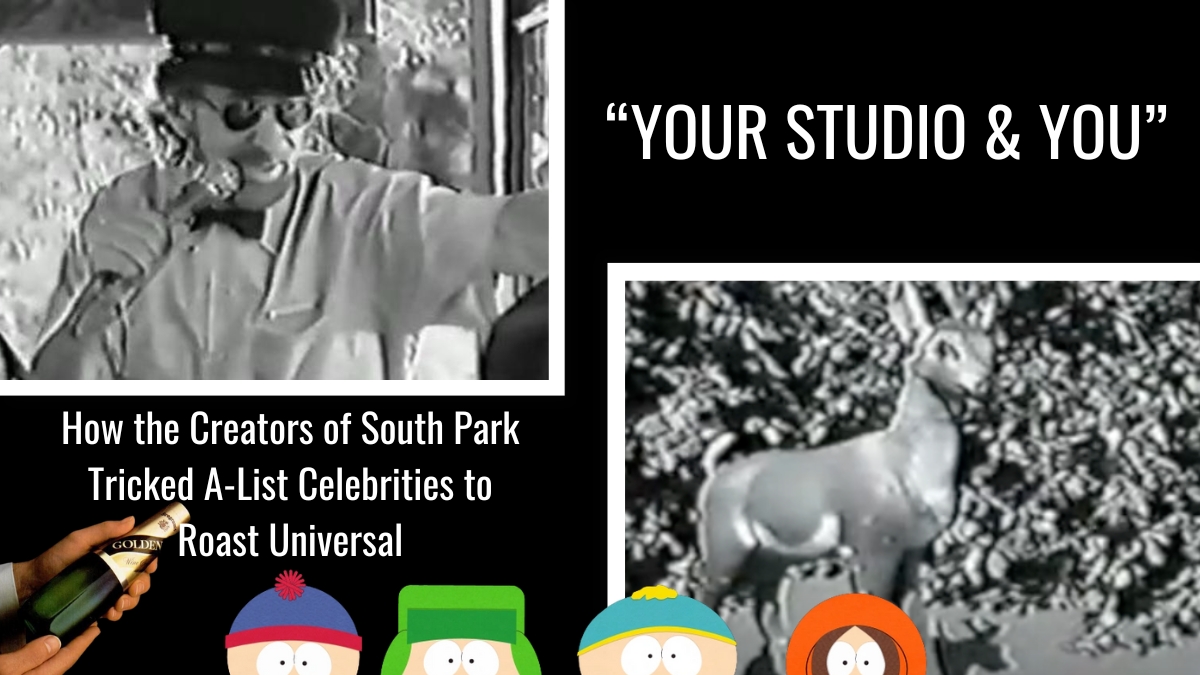
Universal Studios has a rich and storied history, but few moments are as peculiar—and as hilariously cutting—as the creation of Your Studio & You. This 14-minute parody film, commissioned in 1995 to celebrate Universal’s new ownership under Seagram’s, brings together an all-star cast, biting humor, and the unmistakable comedic fingerprints of Matt Stone and Trey Parker.
Long before South Park debuted on Comedy Central in 1997, Stone and Parker were already carving out a reputation for their irreverent style, and Your Studio & You perfectly encapsulates their knack for turning even the most corporate project into something delightfully subversive.
Matt Stone & Trey Parker Before South Park
Stone & Parker were already known out in Hollywood as funny guys. Thanks largely to “The Spirit of Christmas,” which was this video greeting card that they’d crafted for a Fox executive – who then distributed this infamously funny thing (which had Our Lord Jesus Christ & Santa Claus literally duking it out for the holiday affections of Cartman, Kenny, Stan & Kyle) to friends & family.
This was the early 1990s. No internet. Each copy of “The Spirit of Christmas” was made on VHS tape and then mailed. Went viral the old-fashioned way. It’s rumored that George Clooney made over 300 copies of “The Spirit of Christmas” and passed these VHS taps along to friends and family.
Things didn’t move as fast as they do today. “The Spirit of Christmas” still became a sensation out West.
Zucker Brothers
Matt & Trey also had other supporters in the entertainment industry. Among them David Zucker, who was one of the members of ZAZ (i.e., Zucker Abrahams Zucker), the talented trio that made “Airplane!” in 1980, “Top Secret!” in 1984 and the three “Naked Gun” movies.
- The original “Naked Gun” in 1988
- “Naked Gun 2 & 1/2 : The Smell of Fear” in 1991
- and “Naked Gun 33 & a 1/3: The Final Insult” in 1994
All five of these parody films had been made for Paramount Pictures. But in the Late Winter / Early Spring of 1995, Universal had persuaded the Zucker Brothers to come over and set up shop in a bungalow on their lower lot. With the hope that – at some point further on down the line – David & his brother Jerry would start making funny films for Universal.
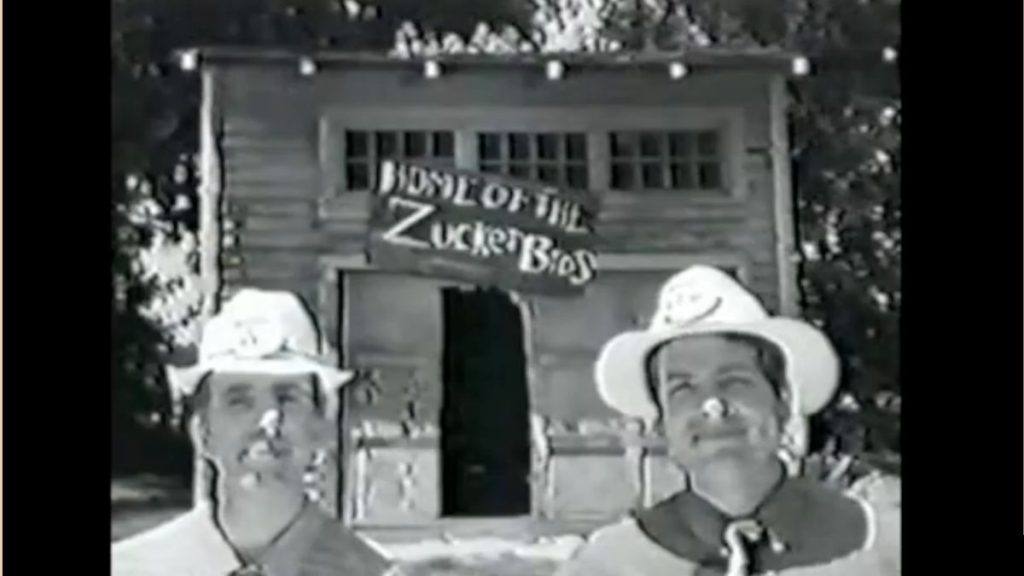
And it’s during this same window of time (We’re now talking April of 1995) that news breaks that Seagrams (Yep, the adult beverage company. Who – at the time – was making an absolute fortune on the sales of wine coolers) was about to buy a majority stake in MCAUniversal. We’re talking control of 80% of that company’s stock. Which would effectively make Seagrams the new owners of Universal Studios.
Edgar Bronfman
And Edgar Bronfman – the owner of Seagrams – knew that Universal had had a tough time with its previous owners – which had been the Matsushita Electric Industrial Co. of Japan. Matsushita had bought MCA back in November of 1990 for $7.5 billion but had never really understood the entertainment industry.
This is why – after repeatedly butting heads with Lew Wasserman & Sidney Sheinberg (i.e., the heads of Universal Studios & the Universal theme park respectively) when it came to creative control of this company – Matsushita decided to wash it hands of the entire enterprise. Agreeing to sell their holdings in MCA to Seagrams for $5.7 billion (effectively taking a nearly $2 billion loss on this investment).
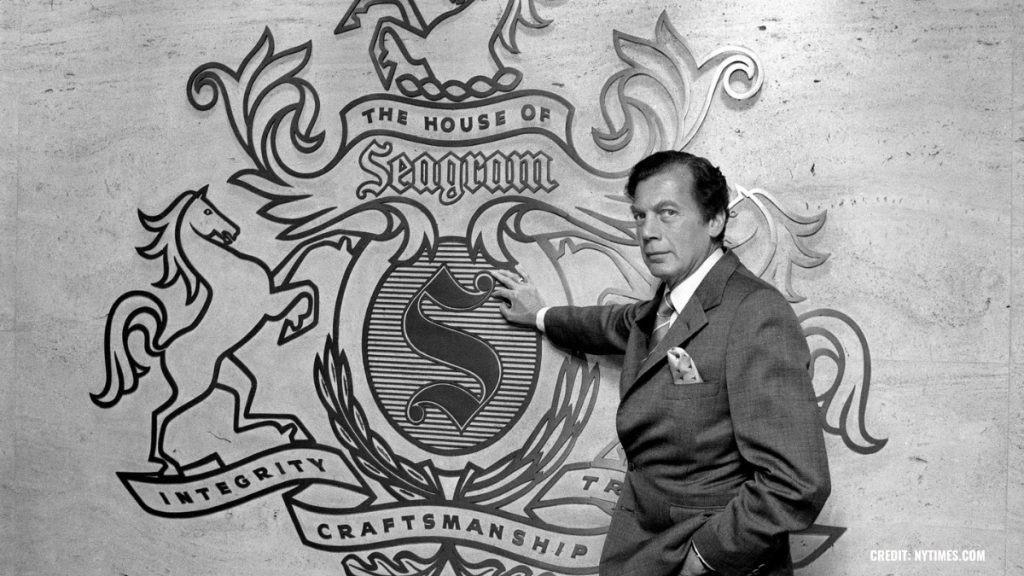
And Bronfman … He knew that some bad feeling had developed between Hollywood’s creative community and the Japanese owners of Universal. The thinking was that executives at Matsushita Electric had just not gotten what it took to make movies & TV shows.
And Edgar? Right from the get-go, he wanted to show that Seagrams was NOT going to be Matsushita Electric Redux. Bronfman was looking for a way to send a clear message to Hollywood’s creative community that Universal’s new owners got it. That they were willing to work with Hollywood to make the best possible movies & TV shows at Universal.
And how did Edgar decide to get this message across? By making a funny movie.
Zucker Commissions Trey Parker for “Your Studio & You”
Mind you, Bronfman himself didn’t make this film. The owner of Seagrams reached out to David Zucker. Who – after initially agreeing to produce this introduction-to-Universal film – then farmed out the production of the actual project to Trey Parker. Who – just two days before shooting was supposed to star on the Universal Lot – persuaded Matt Stone to come help him on this project.
Which brings us to “Your Studio and You.” Which is a parody of an educational film from the 1950s, right down to being shot in black & white and featuring a very generic soundtrack.
Now what’s amazing about watching “Your Studio and You” today is that this 14-minute-long film features some of the biggest names working in Hollywood back in the mid-1990s. We’re talking about people like recent Golden Globe winner Demi Moore, Sylvester Stallone, Michael J. Fox and Angela Lansbury. Not to mention two of the most powerful men in all of Hollywood, Steven Spielberg & Jeffrey Katzenberg.
And what’s especially interesting about watch “Your Studio and You” is that – as you watch these performers go through their paces in this motion pictures (which – most of the time – involves doing some innocuous task while holding a Seagram’s wine cooler) – you often get the feeling that this star is not in on the gag.
So how did Matt & Trey get away with this? Simple. There was never actually a script for “Your Studio and You.”
Filming “Your Studio & You” at Universal Studios Hollywood
Mind you, David Zucker would always insist that there was. Especially when he’d phone up celebrities on the Universal Lot and say “Hey, I’m sending over a couple of college kids later today. They’re working with me on a new parody film. It’s something that we’re doing for the new owners of Universal. I need just a half hour of your time. We’re shooting something special for the party we’ll be holding when the Seagrams people first arrive at the Studio. Absolutely. You’ll definitely get an invite to that party. So can I count on you to help these kids out? Beautiful. They’ll be over there later this morning.”
And then Matt & Trey would show up and say “… Dang, Miss Lansbury. We’re sorry. We must have left our copy of the ‘Your Studio and You’ script back in our office. Which is clear on the other side of the Lot. So – rather than waste your time – why don’t we do this instead? Follow us over to the Psycho House. Where we’re then going to get footage of you painting the front porch on Mother Bates’ house while you say ‘Gosh, with all of the wonderful improvements going on around here, everyone is going to want to work at Universal.’ Oh, and can we also get you to wear this button on the front of your blazer which reads ‘Universal is A-OK’ ? “

And over & over again, the biggest names who were working for Universal at that time took part in the production of “Your Studio & You” because A) David Zucker vouched for Matt Stone & Trey Parker and B) this was something that was being made for the new owners of Universal. And it’s just natural to want to get in good with the new boss.
Steven Spielberg, Jeffery Katzenberg, and Jaws
But no one at Universal anticipated that “Your Studio & You” would wind up being as sharp edged as the finished product turned out to be. I mean, it’s one thing to bite the hand that feeds you. But “Your Studio & You” ? It doesn’t just bite the hand. It takes the hand off at the wrist.
It’s a brutally funny film. With one of the meanest moments reserved for Steven Spielberg, who plays a driver on the Universal Studio Tour who’s trying to persuade a tram full of bored tourists (one of whom is played by Jeffery Katzenberg) that the “Shark Attack” scene down by Jaws Lagoon is actually exciting.
Spielberg actually says lines like “ … Whoa, whoa. What is going on here? Ladies and gentlemen, this never happens. Look out! It’s a shark! Whoa, that is one big scary shark.”

Mind you, as footage of this mechanical shark repeatedly coming up out of the water is shown, “Your Studio & You” ‘s off-screen narrator (who is voiced by Trey Parker says):
“But what about tomorrow? If we don’t keep in step with the times, things that were once neat and thrilling can become old and stupid.”
“Your Studio & You” Reception
This film was supposed to be shown only once at the welcoming party for Seagrams executive on the Universal Lot. And I’m told that – when Edgar Bronfman saw the finished product at that party – he reportedly turned to David Zucker and said “ … That’s a little more mean-spirited that I think it needed to be.”
And with that, “Your Studio & You” was supposed to go back into the Universal vault, never to be seen again. But when “South Park” debuted on Comedy Central in August of 1997 and then became a sensation for its biting humor, there was suddenly a lot of interest in what else Matt & Trey had done. Which is why copies of “The Spirit of Christmas” began to circulate. And – over time – copies of “Your Studio & You” began to bubble up.
Which – as Stone & Parker have repeatedly pointed out – was just not supposed to happen. Largely because none of the celebrities who appeared in “Your Studio & You” had never signed releases for Universal’s legal department. Because – again – this was for a movie that was only going to be shown once at a private function on the Universal Lot.
Matt mentioned (as part of a career retrospective at the Paley Center in LA back in 2000) that “ … they wouldn’t even let us keep a copy of the finished film.”
It’s a funny but brutal movie. And worth taking a look at today especially if you’re a theme park history buff because it shows Universal Studios Hollywood’s “Jurassic Park: The Ride” still under construction on the Lower Lot. That attraction would finally open to the public in June of 1996.
“Your Studio & You” became a lot easier to see after Seagrams sold off its share of Universal to Vivendi in 2000. Copies began propagating online after that. Though Universal Legal will periodically make an effort to get the latest copy of “Your Studio & You” taken off the Internet because – again – none of the performers who appear on camera ever signed the proper releases and/or were paid for their efforts.
That said, if you’re up for a mean-spirited laugh, “Your Studio & You” is well worth 14 minutes of your time. That said, once you watch this thing, be warned:
- You’re immediately going to be thirsty for a Seagram’s wine cooler
- And you’re going to have a sudden desire to go out & buy a porcelain deer.
Theme Parks & Themed Entertainment
Disney and Macy’s 90-Year Thanksgiving Day Parade Partnership: From Mickey’s First Balloon to Minnie’s Big Debut
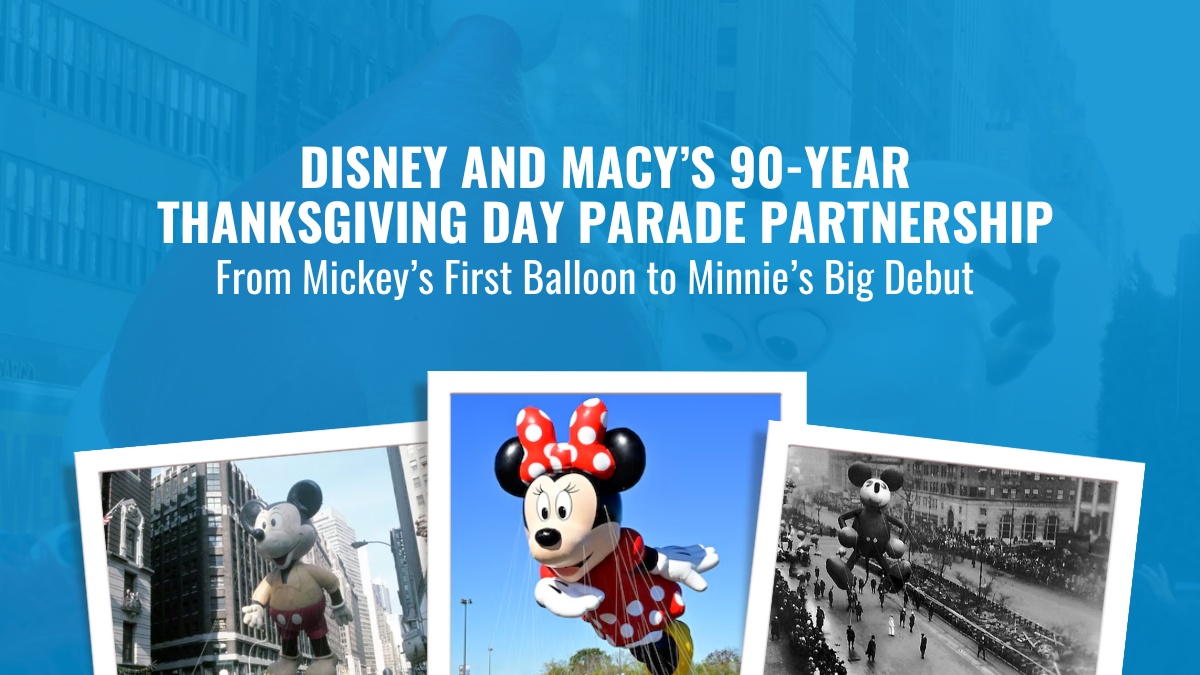
Now, folks, if you’re like me, Thanksgiving just wouldn’t be the same without a coffee, a cozy seat, and Macy’s Thanksgiving Day Parade on the TV. And if you’re really like me, you’re watching for one thing: Disney balloons floating down 34th Street. Ever wondered how Mickey, Donald, and soon Minnie Mouse found their way into this beloved New York tradition? Well, grab your popcorn because we’re diving into nearly 90 years of Disney’s partnership with Macy’s.
The Very First Parade and the Early Days of Balloons
The Macy’s Thanksgiving Day Parade goes way back to 1924, but if you can believe it, balloons weren’t part of the festivities until 1927. That first lineup included Felix the Cat, a dragon, and a toy soldier, all towering above the crowds. Back then, Macy’s had a pretty wild idea to end the parade: they would let the balloons drift off into the sky, free as birds. But this wasn’t just Macy’s feeling generous. Each balloon had a message attached, offering a $100 reward (about $1,800 in today’s dollars) for anyone who returned it to the flagship store on 34th Street.
And here’s where it gets interesting. This tradition carried on for a few years, right up until 1932, when Felix the Cat almost took down a plane flying over New York City! Imagine that—you’re flying into LaGuardia, and suddenly, there’s a 60-foot balloon drifting toward your wing. Needless to say, that was the end of Macy’s “fly away” stunt, and from then on, the balloons have stayed firmly grounded after the parade ends.

1934: Mickey Mouse Floats In, and Disney Joins the Parade
It was 1934 when Mickey Mouse finally made his grand debut in the Macy’s parade. Rumor has it Walt Disney himself collaborated with Macy’s on the design, and by today’s standards, that first Mickey balloon was a bit of a rough cut. This early Mickey had a hotdog-shaped body, and those oversized ears gave him a slightly lopsided look. But no one seemed to mind. Mickey was there, larger than life, floating down the streets of New York, and the crowd loved him.
Mickey wasn’t alone that year. He was joined by Pluto, Horace Horsecollar, and even the Big Bad Wolf and Practical Pig from The Three Little Pigs, making it a full Disney lineup for the first time. Back then, Disney wasn’t yet the entertainment powerhouse we know today, so for Walt, getting these characters in the parade meant making a deal. Macy’s required its star logo to be featured on each Disney balloon—a small concession that set the stage for Disney’s long-standing presence in the parade.
Duck Joins and Towers Over Mickey
A year later, in 1935, Macy’s introduced Donald Duck to the lineup, and here’s where things got interesting. Mickey may have been the first Disney character to float through the parade, but Donald made a huge splash—literally. His balloon was an enormous 60 feet tall and 65 feet long, towering over Mickey’s 40-foot frame. Donald quickly became a fan favorite, appearing in the lineup for several years before being retired.
Fast-forward a few decades, and Donald was back for a special appearance in 1984 to celebrate his 50th birthday. Macy’s dug the balloon out of storage, re-inflated it, and sent Donald down 34th Street once again, bringing a bit of nostalgia to the holiday crowd.
A Somber Parade in 2001
Now, one of my most memorable trips to the parade was in 2001, just weeks after the 9/11 attacks. Nancy and I, along with our friends, headed down to New York, and the mood was something I’ll never forget. We watched the start of the parade from Central Park West, but before that, we went to the Museum of Natural History the night before to see the balloons being inflated. They were covered in massive cargo nets, with sandbags holding them down. It’s surreal to see these enormous balloons anchored down before they’re set free.
That year, security was intense, with police lining the streets, and then-Mayor Rudy Giuliani rode on the Big Apple float to roaring applause. People cheered his name, waving and shouting as he passed. It felt like the entire city had turned out to show their resilience. Even amidst all the heightened security and tension, seeing those balloons—brought a bit of joy back to the city.

Balloon Prep: From New Jersey’s MetLife Stadium to California’s D23 Expo
Each year before the parade, Macy’s holds a rehearsal event known as Balloon Fest at MetLife Stadium in New Jersey. This is where handlers get their first crack at guiding the balloons, practicing with their parade masters, and learning the ropes—literally. It’s an entire production unto itself, with dozens of people rehearsing to make sure these enormous inflatables glide smoothly down the streets of New York on parade day.
In 2015, Macy’s took the balloon show on the road, bringing their Buzz Lightyear balloon out to California for the D23 Expo. I was lucky enough to be there, and watching Buzz get inflated piece by piece in the Anaheim Convention Center parking lot was something to behold. Each section was filled with helium in stages, and when they got around to Buzz’s lower half, well, there were more than a few gas-related jokes from the crowd.
These balloons seem to have a personality all their own, and seeing one like Buzz come to life up close—even outside of New York—had all the excitement and anticipation of the real deal.

Mickey’s Comeback as a Bandleader and Sailor Mickey
After a long hiatus, Mickey Mouse made his return to the Macy’s parade in 2000, this time sporting a new bandleader outfit. Nine years later, in 2009, Sailor Mickey joined the lineup, promoting Disney Cruise Line with a nautical twist. Over the past two decades, Disney has continued to enchant parade-goers with characters like Buzz Lightyear in 2008 and Olaf from Frozen in 2017. These balloons keep Disney’s iconic characters front and center, drawing in both longtime fans and new viewers.
But ever wonder what happens to the balloons after they reach the end of 34th Street? They don’t just disappear. Each balloon is carefully deflated, rolled up like a massive piece of laundry, and packed into storage bins. From there, they’re carted back through the Lincoln Tunnel to Macy’s Parade Studio in New Jersey, where they await their next flight.

Macy’s Disney Celebration at Hollywood Studios
In 1992, Macy’s took the spirit of the parade down to Disney-MGM Studios in Orlando. After that year’s parade, several balloons—including Santa Goofy, Kermit the Frog, and Betty Boop—were transported to Hollywood Studios, re-inflated, and anchored along New York Street as part of a holiday display. Visitors could walk through this “Macy’s New York Christmas” setup and see the balloons up close, right in the middle of the park. While this display only ran for one season, it paved the way for the Osborne Family Spectacle of Dancing Lights, which became a holiday staple at the park for years to come.

Minnie Mouse’s Long-Awaited Debut in 2024
This year, Minnie Mouse will finally join the parade, making her long-overdue debut. Macy’s is rolling out the red carpet for Minnie’s arrival with special pop-up shops across the country, where fans can find exclusive Minnie ears, blown-glass ornaments, T-shirts, and more to celebrate her first appearance in the Thanksgiving Day Parade.

For those lucky enough to catch the parade this year, you’ll see Minnie take her first float down 34th Street, decked out in her iconic red bow and polka-dot dress. Macy’s and Disney are also unveiling a new Disney Cruise Line float honoring all eight ships, including the latest, the Disney Treasure.
As always, I’ll be watching from my favorite chair, coffee in hand, as Minnie makes her grand entrance. The 98th annual Macy’s Thanksgiving Day Parade airs live on NBC, and it’s a tradition you won’t want to miss—whether you’re on 34th Street or tuning in from home.
-
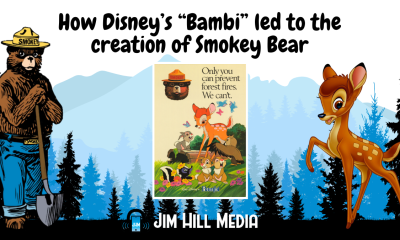
 Film & Movies11 months ago
Film & Movies11 months agoHow Disney’s “Bambi” led to the creation of Smokey Bear
-

 Merchandise12 months ago
Merchandise12 months agoIntroducing “I Want That Too” – The Ultimate Disney Merchandise Podcast
-

 Theme Parks & Themed Entertainment6 months ago
Theme Parks & Themed Entertainment6 months agoDisney’s Forgotten Halloween Event: The Original Little Monsters on Main Street
-

 Theme Parks & Themed Entertainment7 months ago
Theme Parks & Themed Entertainment7 months agoThe Story of Mickey’s Not-So-Scary Halloween Party: From One Night to a Halloween Family Tradition
-

 Film & Movies6 months ago
Film & Movies6 months agoHow “An American Tail” Led to Disney’s “Hocus Pocus”
-

 Theme Parks & Themed Entertainment4 months ago
Theme Parks & Themed Entertainment4 months agoDisney and Macy’s 90-Year Thanksgiving Day Parade Partnership: From Mickey’s First Balloon to Minnie’s Big Debut
-

 Television & Shows3 months ago
Television & Shows3 months agoHow the Creators of South Park Tricked A-List Celebrities to Roast Universal – “Your Studio & You”
-

 History2 months ago
History2 months agoThe Super Bowl & Disney: The Untold Story Behind ‘I’m Going to Disneyland!’






